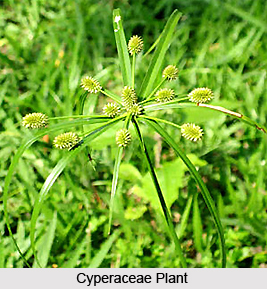 Cyperaceae is regarded as an indigenous medicinal plant in India. It is widely distributed in the rice fields and other wet, open habitats throughout the country. Cyperus iria L. is the scientific name by which the shrub is known in the medical world. Cyperaceae is however widely popular as Burachucha in Bengali and Dabbe jambu hullu in Kannada, the local dialects under the Indian languages.
Cyperaceae is regarded as an indigenous medicinal plant in India. It is widely distributed in the rice fields and other wet, open habitats throughout the country. Cyperus iria L. is the scientific name by which the shrub is known in the medical world. Cyperaceae is however widely popular as Burachucha in Bengali and Dabbe jambu hullu in Kannada, the local dialects under the Indian languages.
Cyperaceae bears several essential properties, described by its smoothness and being hairless. This Indian medicinal plant is an annual herb, with fibrous roots and a tufted, striate, 3-angled stem, which usually ranges from 35 cm to 50 cm in length. Leaves of this medicinal plant are shorter compared to the stem, also containing multi-striations with finely acuminate apex. The inflorescence (umbel) is composed of several primary rays of length, ranging from 2.5 cm to 12.5 cm. These inflorescences possess properties that possess narrow umbellules and few-flowered spikelets. The bracts measure 3 to 5 in number, which grow up to 20 cm in length; the spikelets of Cyperaceae range from 0.6-0.8 cm in length, and vary from linear to oblong shape. The glumes of this Indian medicinal plant are 1.2-2.5 mm long. It is elliptic-ovate in shape and has obtuse shaped apex. Achenes of Cyperaceae medicinal plants are 1-2 mm in length. These are 0.5 mm to 0.8 mm in width which is obovate in structure. They become brown or black on maturing.
Cyperaceae is important for its medicinal purposes. Its different parts are used to prepare tonic, stimulant, stomachic and astringent.



















